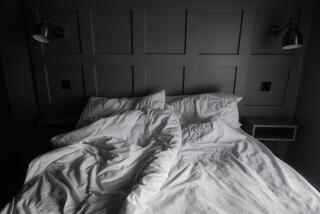Waking up to breathing problems
Sometimes there’s a clear reason we’re wired, tired and desperate at 3 a.m. Work pressure. A broken relationship. Threats of terror. But very often people with chronic insomnia have no idea why they’re waking up at night.
“That’s why they come and ask for help,” said Dr. Barry Krakow, director of the Sleep and Human Health Institute, a research clinic in Albuquerque that specializes in the treatment of insomnia due to trauma-related stress. “They think, ‘I must be stressed about something,’ but they don’t know what. They don’t have an answer.”
Krakow and other sleep researchers believe they do. In an article published in the current issue of the journal Sleep and Breathing, they contend that chronic insomniacs’ increasingly fragmented sleep can cause a change in nighttime breathing. Periodically through the night, their respiration slows down just enough to make the body stir but not awaken. The condition, called sleep-disordered breathing -- similar to the better-known sleep apnea -- has long been associated with severe insomnia. But these doctors say the disorder is more common than previously thought, and makes chronic insomnia nearly impossible to treat with standard behavioral therapies, such as setting regular sleep routines.
An ‘under-diagnosed condition’
By opening airways in the nose and mouth, they say, doctors should be able to spare chronic insomniacs the mental and physical ravages of sleeplessness, whether due originally to work stress or violent trauma. “The bottom line is that this is a subtle, vastly under-diagnosed condition that gives us an opportunity to help perhaps millions of people suffering from a variety of problems related to chronic insomnia,” Krakow said.
Other researchers caution there’s still debate about the definition of sleep-disordered breathing and no one knows how widespread it is. After all, experts only recently have come to understand the seriousness of sleep apnea, a condition affecting about 2% of adults in which breathing stops periodically during sleep, leaving people half-awake by night and exhausted by day.
Yet researchers who study nighttime breathing increasingly agree that sleep-disordered breathing plays an enormous role in sleep complaints, said Dr. Christian Guilleminault of Stanford University School of Medicine, a leading authority on the disorder.
In two recent studies, more than 80% of chronic insomniacs reported symptoms of sleep-disordered breathing. In one, Krakow used measuring devices to show that 40 of 44 victims of violent crime visiting his clinic had the disorder. Its symptoms disturbed their sleep 40 times an hour, on average. In another, Guilleminault reported in July that 327 of 394 post-menopausal women seeking treatment at Stanford had symptoms.
Dr. Avram Gold, medical director of the sleep disorders center at the State University of New York in Stony Brook, said most patients at the clinic have breathing trouble at night, whether they snore or not. “For years we’ve been so focused on the extreme -- severe apnea -- that I think we’ve been missing the more subtle problems,” he said. In a paper published in May, Gold argued that most nighttime breathing problems fall somewhere between normal and apnea, and go undiagnosed in millions of people. “I believe apnea is just the tip of the iceberg.”
A range of treatments
Doctors treat nighttime breathing problems several ways. For sleep apneas, the method that works best is continuous positive airway pressure, or CPAP. Patients wear a mask at night to regulate breathing, ensuring healthy oxygen flow. For less severe cases, doctors often recommend dental appliances that push the jaw forward to open throat passages or that help open nasal airways.
In his study among post-menopausal insomniacs, Guilleminault assigned patients to two groups: one that got therapy for sleep-disordered breathing and another that received traditional behavioral therapy for insomnia, including advice on setting sleep schedules and using the bed exclusively for sleeping. After six months, both groups were doing better. But only those who got treatment for their sleep-disordered breathing reported significantly less daytime fatigue. “I think what we’re going to find is that what works best for many insomniacs is a combination of these therapies,” Guilleminault said.
Krakow has been treating breathing problems with a combination of approaches, including the nasal strips some athletes use to keep passages open. One patient, Robert Brocato, 40, an electrical engineer in Albuquerque, said that for years he got little more than three or four hours of good sleep a night before seeing Krakow last summer. He’d tried sleeping pills; he’d tried altering his sleep schedule. “It didn’t help,” Brocato said, “and the sleep problems were really starting to affect my moods during the day. I’m naturally pretty tense, but suddenly I had a real edge.... People would say things to me and I’d just blow up.”
After a month of using a nasal strip as well as a dental appliance at night, Brocato noticed that the time he spent awake at night went from two hours to half an hour. Now it’s close to zero. The change in his waking life has been subtle, he said. “The most noticeable thing is that I have more awareness and better control of my emotions. If I’m getting angry it’s much easier now for me to say, ‘Hey, this is silly,’ and drop it.”
Doctors don’t have enough evidence to say which treatments work best. The area is too experimental for insurance coverage, and little is known about how psychological problems such as depression interact with breathing problems. But as the word spreads about the disorder, sleep clinics expect to see many more patients. “Here on Long Island, we are already getting referrals for it,” Gold said. “I expect in the coming year we’re going to hear much more about it.”





